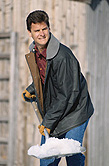Don't Miss
- Skip Storing This Everyday Product in the Fridge Door
- Green Tea + B3 Pairing May Boost Brain Health
- Navigating Your Midlife Crisis: Embracing New Possibilities
- City Raccoons Showing Signs of Domestication
- Mapping the Exposome: Science Broadens Focus to Environmental Disease Triggers
- One Week Less on Social Media Linked to Better Mental Health
- Your Brain Changes in Stages as You Age, Study Finds
- Some Suicide Victims Show No Typical Warning Signs, Study Finds
- ByHeart Formula Faces Lawsuits After Babies Sickened With Botulism
- Switch to Vegan Diet Could Cut Your Greenhouse Gas Emissions in Half
A Survival Guide for Winter’s Threats
By LadyLively on February 2, 2014


Every winter, many Americans suffer broken bones, muscle tears, sprains and strains from shoveling snow or falling on icy sidewalks and streets.
Orthopedic surgeons at the Icahn School of Medicine at Mount Sinai in New York City are offering tips to help prevent fall-related injuries.
- One suggestion is to ask your doctor about strengthening exercises that will improve your balance, which can make a big difference when walking on ice.
- Try to avoid icy spots. But if you have to venture over them, remember that walking in a shuffle or moving your feet only slightly apart will give you better balance than using your normal stride. Keeping a slight bend in your knees also helps.
- If you’re walking on an ice-covered hill, turn sideways and avoid crossing one foot over the other. Instead, take sidesteps in which you bring your other foot along to meet your lead foot. Keep your knees bent for better balance.
- Always check for icy patches when walking, or getting out of cars, buses and trains or when going up and down outdoor stairs.
- To protect your dominant arm if you fall, carry an object or bag in your dominant hand. This will make you more likely to use your non-dominant arm to break a fall.
The surgeons also outlined ways to reduce the risk of injuries while shoveling snow.
- Warm up your muscles with 10 minutes of light exercise before your start shoveling.
- Use a shovel that suits your height and strength. Don’t use a shovel that is too long or heavy for you.
- Try to push the snow instead of lifting it. If you must lift snow, squat with your legs apart, knees bent and back straight. Lift with your legs.
- Carry small amounts of snow to where you want to place it. Don’t toss snow over your shoulder or to the side. This type of twisting motion stresses your back.
More information
The U.S. Centers for Disease Control and Prevention has more about winter health and safety.
Source: HealthDay
Copyright © 2025 HealthDay. All rights reserved.










